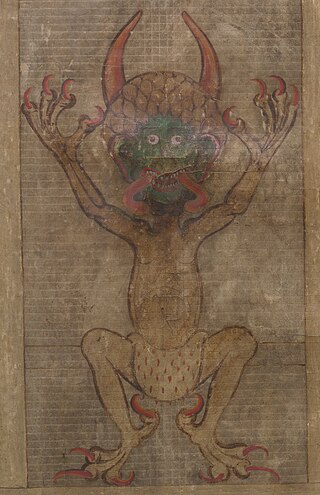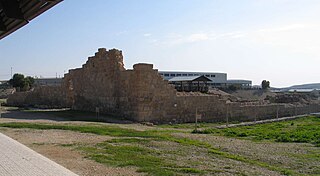
Jericho is a city in the West Bank; it is the administrative seat of the Jericho Governorate of the State of Palestine. Jericho is located in the Jordan Valley, with the Jordan River to the east and Jerusalem to the west. In 2017, it had a population of 20,907.

Joshua, also known as Yehoshua, Jeshoshua, or Josue, functioned as Moses' assistant in the books of Exodus and Numbers, and later succeeded Moses as leader of the Israelite tribes in the Book of Joshua of the Hebrew Bible. His name was Hoshea the son of Nun, of the tribe of Ephraim, but Moses called him "Yehoshua", the name by which he is commonly known in English. According to the Bible, he was born in Egypt prior to the Exodus.

Satan, also known as the Devil, and sometimes also called Lucifer in Christianity, is an entity in Abrahamic religions that seduces humans into sin or falsehood. In Judaism, Satan is seen as an agent subservient to God, typically regarded as a metaphor for the yetzer hara, or "evil inclination". In Christianity and Islam, he is usually seen as a fallen angel or jinn who has rebelled against God, who nevertheless allows him temporary power over the fallen world and a host of demons. In the Quran, Shaitan, also known as Iblis, is an entity made of fire who was cast out of Heaven because he refused to bow before the newly created Adam and incites humans to sin by infecting their minds with waswās.

Qumran is an archaeological site in the West Bank managed by Israel's Qumran National Park. It is located on a dry marl plateau about 1.5 km (1 mi) from the northwestern shore of the Dead Sea, about 10 km (6 mi) south of the historic city of Jericho, and adjacent to the modern Israeli settlement and kibbutz of Kalya.

Mūsā ibn ʿImrān is a prominent prophet and messenger of God and is the most frequently mentioned individual in the Quran, with his name being mentioned 136 times and his life being narrated and recounted more than that of any other prophet. He is one of the most important prophets and messengers of Islam.

Mount Nebo is an elevated ridge located in Jordan, approximately 700 metres (2,300 ft) above sea level. Part of the Abarim mountain range, Mount Nebo is mentioned in the Bible as the place where Moses was granted a view of the Promised Land before his death. The view from the summit provides a panorama of the West Bank across the Jordan River valley. The city of Jericho is usually visible from the summit, as is Jerusalem on a very clear day. The biblical town of Nebo, now known as Khirbet al-Mukhayyat, is located 3.5 km away.

In the New Testament, Salome was a follower of Jesus who appears briefly in the canonical gospels and in apocryphal writings. She is named by Mark as present at the crucifixion and as one of the Myrrhbearers, the women who found Jesus's empty tomb. Interpretation has further identified her with other women who are mentioned but not named in the canonical gospels. In particular, she is often identified as the wife of Zebedee, the mother of James and John, two of the Twelve apostles. In medieval tradition Salome was counted as one of the Three Marys who were daughters of Saint Anne, so making her the sister or half-sister of Mary, mother of Jesus.

A Maggot (1985) is a novel by British author John Fowles. It is Fowles' sixth major novel, following The Collector, The Magus, The French Lieutenant's Woman, Daniel Martin and Mantissa. Its title, as the author explains in the prologue, is taken from the archaic sense of the word that means "whim", "quirk", "obsession", or even a snatch of music. Another meaning of the word "maggot" becomes apparent later in the novel, used by a character to describe a white, oblong machine that appears to be a spacecraft. Though the author denied that A Maggot is a historical novel, it does take place during a precise historical timeframe, April 1736 to March 1737, in England. It might be variously classified as historical fiction, mystery, or science fiction. Because of the narrative style and various metafictional devices, most critics classify it as a postmodern novel.

The temptation of Christ is a biblical narrative detailed in the gospels of Matthew, Mark, and Luke. After being baptized by John the Baptist, Jesus was tempted by the devil after 40 days and nights of fasting in the Judaean Desert. At the time, Satan came to Jesus and tried to tempt him. Jesus having refused each temptation, Satan then departed and Jesus returned to Galilee to begin his ministry. During this entire time of spiritual battle, Jesus was fasting.

Luke 4 is the fourth chapter of the Gospel of Luke in the New Testament of the Christian Bible, traditionally attributed to Luke the Evangelist, a companion of Paul the Apostle on his missionary journeys. This chapter details Jesus' three temptations, the start of his "Galilean Ministry", and his rejection at Nazareth, which Luke contrasts with his acclaim in nearby Capernaum.

The Judaean Desert or Judean Desert is a desert in the West Bank and Israel that lies east of the Judaean Mountains, so east of Jerusalem, and descends to the Dead Sea. Under the name El-Bariyah, it has been nominated to the Tentative List of World Heritage Sites in the State of Palestine, particularly for its monastic ruins.

Darkwing is a 2007 young adult fantasy novel by Canadian author Kenneth Oppel. It is the prequel and fourth book of the Silverwing series, and takes place 65 million years before the events of the first book. It describes the origins of the war between the birds and the beasts.

Mount of Temptation, in Palestinian Arabic Jebel Quruntul, is a mountain over the city of Jericho in the West Bank, in the State of Palestine; ancient Christian tradition identifies it as the location of the temptation of Jesus described in the New Testament Gospels of Matthew, Mark, and Luke, in which it is said that, from "a high place", the Devil offered Jesus rule over all the kingdoms of the world.

The Monastery of the Temptation is a Greek Orthodox monastery located in Jericho, Palestine. It was built on the slopes of the Mount of Temptation 350 meters above sea level, situated along a cliff overlooking the city of Jericho and the Jordan Valley. Its most ancient structures date back to the 6th century, having been built above the cave traditionally said to be that where Jesus spent forty days and forty nights fasting and meditating while he was tempted by Satan.

The Monastery of Euthymius started as a lavra-type monastic settlement in the Judaean desert, founded by Saint Euthymius the Great (377–473) in 420, known as the Laura or Lavra of Euthymius. After its final abandonment in the 13th century, it was repurposed as a caravanserai and became known as Khan el-Ahmar, the Red Caravanserai, khan being an originally Persian word for inn or caravanserai. Its ruins still stand a short distance south of today's main Jerusalem-Jericho highway in the West Bank.

"Pape Satàn, pape Satàn aleppe" is the opening line of Canto VII of Dante Alighieri's Inferno. The line, consisting of three words, is famous for the uncertainty of its meaning, and there have been many attempts to interpret it. Modern commentators on the Inferno view it as some kind of demonic invocation to Satan.
The term Bible fiction refers to works of fiction which use characters, settings and events taken from the Bible. The degree of fictionalization in these works varies and, although they are often written by Christians or Jews, this is not always the case.
The Capture of Jericho occurred between 19 and 21 February 1918 to the east of Jerusalem beginning the Occupation of the Jordan Valley during the Sinai and Palestine Campaign of the First World War. Fighting took place in an area bordered by the Bethlehem–Nablus road in the west, the Jordan River in the east, and north of a line from Jerusalem to the Dead Sea. Here a British Empire force attacked Ottoman positions, forcing them back to Jericho and eventually across the Jordan River.

The Inn of the Good Samaritan is a national park, museum, ancient archaeological site and former inn administered by the Israel Nature and Parks Authority located near Ma'ale Adumim, halfway between Jerusalem and Jericho, at an elevation of 298 meters above sea level.
Steve Banning is a character from the Mummy franchise who starred in the movies The Mummy's Hand, The Mummy's Tomb & The Mummy portrayed by Dick Foran in the former 2 and by Felix Aylmer in the latter 1.

















